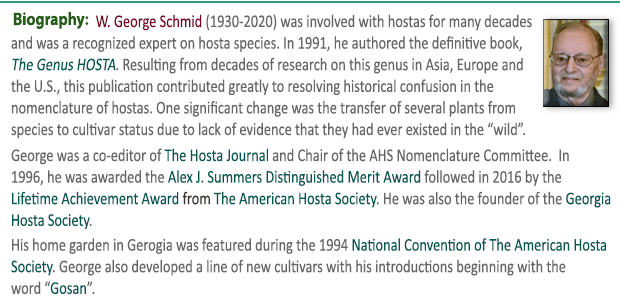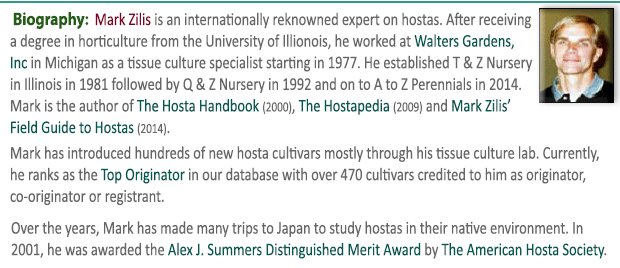|
  According to The Genus Hosta by W. George Schmid (1991), this
Japanese species is similar to
H. kikutii with medium green
foliage.
The term densus pertains to the dense arrangement of
flowers on the raceme. According to The Genus Hosta by W. George Schmid (1991), this
Japanese species is similar to
H. kikutii with medium green
foliage.
The term densus pertains to the dense arrangement of
flowers on the raceme.
"A very pruinose, blue-grey plant
cultivated in North America under the species name H. densa
is not this species, which has medium green
leaves without pruinosity." according to Schmid.
 The Hostapedia by
Mark Zilis (2009) says that H. 'Density' that is found in a few
American gardens although thought to be a sport of H. densa,
is not actually related to it. The Hostapedia by
Mark Zilis (2009) says that H. 'Density' that is found in a few
American gardens although thought to be a sport of H. densa,
is not actually related to it.
This is a medium size plant about
14 to 16 inches high with a spread of around 18 to 22 inches.
Its leaves are dark green on top but lighter on the bottom with
a smooth texture. Pale purple flowers in clusters with
purple-yellow anthers bloom in September followed by viable
seeds.
The New Encyclopedia of Hostas by
Diana
Grenfell (2009) states: "Rarely grown in gardens. A collector's plant...A
tightly packed raceme, as the specific name indicates."

 An article about favorite flowering hostas by W. George Schmid in
The
Hosta Journal (2006 Vol. 37 No. 2) says, "The best
flowers are on H. plantaginea and its multi-petalous cousins, 'Venus'
and
'Aphrodite'...H. capitata in bud is fine, but its offspring, 'Nakaimo' has
flowers that begin with the shine of precious porcelain and stay closed in bud
longer...H. kikutii forms all have fine and late flowers, but the best are on
H. kikutii var. densa (H. densa). They are white and form a tight bunch at the top
of the scape. H. laevigata has large, spidery flowers in abundance; its cousin
H. yingeri has smaller ones with the same spidery character and dark color.
These spidery flowers are carried all around the stem unlike other hosta flowers
that, "lean to one side...Finally, mature clumps of 'Blue Angel' and 'Elegans'
have a beautiful flower display when many flowers on different scapes open in
unison..." An article about favorite flowering hostas by W. George Schmid in
The
Hosta Journal (2006 Vol. 37 No. 2) says, "The best
flowers are on H. plantaginea and its multi-petalous cousins, 'Venus'
and
'Aphrodite'...H. capitata in bud is fine, but its offspring, 'Nakaimo' has
flowers that begin with the shine of precious porcelain and stay closed in bud
longer...H. kikutii forms all have fine and late flowers, but the best are on
H. kikutii var. densa (H. densa). They are white and form a tight bunch at the top
of the scape. H. laevigata has large, spidery flowers in abundance; its cousin
H. yingeri has smaller ones with the same spidery character and dark color.
These spidery flowers are carried all around the stem unlike other hosta flowers
that, "lean to one side...Finally, mature clumps of 'Blue Angel' and 'Elegans'
have a beautiful flower display when many flowers on different scapes open in
unison..."



|



